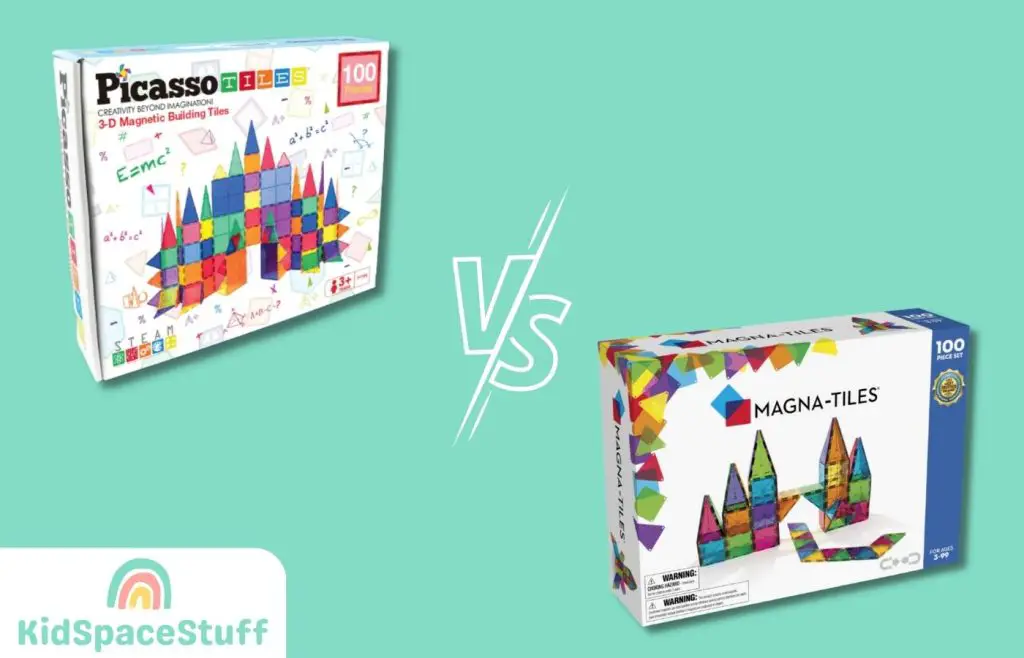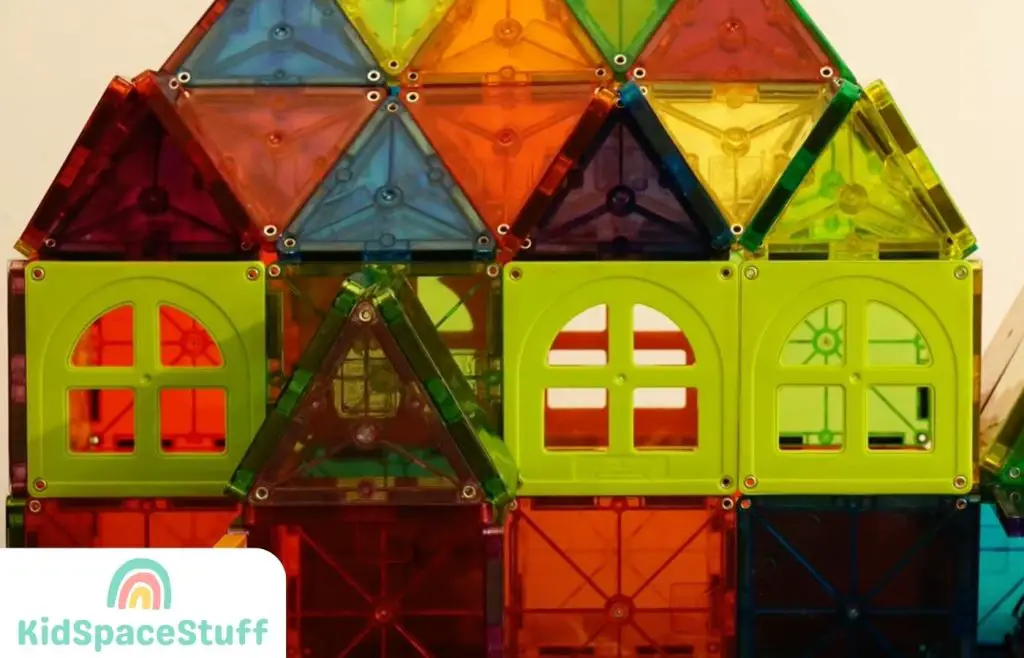As a mom, I’ve witnessed the transformative power of magnetic tiles in my children’s play and learning journey.
Magnetic building tiles like Magna-Tiles and Picasso Tiles have become a mainstay in our home, offering my little ones not just hours of fun, but also a platform for developing fine motor skills and creative thinking.
But which are better?
In this article, I’ll compare the differences between Magna Tiles and Picasso tiles to find out which ones are best for your children. Let’s dig in!
Magna Tiles vs Picasso Tiles

Magna Tiles vs Picasso Tiles: Tile Size and Shapes
Magna-Tiles, designed with larger, square and triangular tiles, cater perfectly to those tiny hands.
The big pieces lead to substantial, eye-catching constructions, promoting collective play as my children work together on their creations. These come in many geometric shape options including:
- Square Tiles
- Small and Large Triangles
- Isosceles Triangles
- Right Triangles
- Rectangles
- Windows
Picasso Tiles, however, take a different approach. They come in a broader range of shapes and sizes, offering my kids a chance to bring their elaborate imaginations to life. These compact tiles are easier to manage and are particularly good for detailed constructions.
Some of the geometric shapes you’ll find include:
- Square Tiles
- Small and Large Triangles
- Isosceles Triangles
- Right Triangles
- Rectangles
- Hexagons
- Diamond Shapes
- Semi-Circles
- Quarter Rounds
Picasso Tiles vs Magna Tiles: Magnet Size and Strength

When it comes to magnet strength, I’ve found a noticeable difference between the two brands.
Magna-Tiles have moderate magnet strength, which usually holds up well for most structures. However, for larger, ambitious projects, the structures occasionally topple over.
Picasso Tiles shine in this area, equipped with stronger magnets than . They securely hold together even complex 3D designs, providing my kids with a seamless building experience that rarely ends in frustration due to collapsing structures.
Magna Tiles vs Picasso Tiles: Quality
Quality-wise, both brands have lived up to expectations.
Magna-Tiles, with their robust build, have endured countless playtimes. The durability of these tiles has made them a lasting favorite in our household, maintaining their shape and color despite heavy use.
Picasso Tiles, although lighter, have proven resilient. The clear, colorful tiles resist scratches and cracks remarkably well, maintaining their aesthetic appeal over time. They’ve stayed functional and attractive even after being passed down to younger siblings.
Both of these STEM toys will last for years and can sharpen your children’s engineering skills in no time.
Picasso Tiles vs Magna Tiles: Weight
Magna-Tiles are significantly heavier due to their size and solid construction, which offers a sense of stability during playtime. Their weight adds a feeling of substance and durability to their constructions.
Picasso Tiles, on the other hand, are lighter, making them more manageable for younger children and easier to transport. They’ve become our go-to choice for outings, trips, and visits to grandma’s house.
Compatibility
Magna-Tiles, a brand known for its high-quality and robust tiles, are wonderfully compatible with other brands. The magnetic strength and connection points of Magna-Tiles have seamlessly integrated with several other magnetic tile brands in our playroom. This flexibility allows my children to build more expansive and diverse structures, and it’s also cost-effective, letting us add variety to our collection without needing to stick to a single brand.
Picasso Tiles, on the other hand, are slightly smaller but equally versatile. Their magnet strength and design are flexible enough to allow easy mixing and matching with other brands of magnetic tiles. In my experience, Picasso Tiles have integrated well with most other brands we’ve tried, providing my children with a broader canvas for their creativity.
Safety
When it comes to safety, both Magna-Tile and Picasso Tiles have proven to be reliable choices. Magna-Tiles, with their larger design and rounded edges, reduce the risk of accidental swallowing and offer a safe playtime experience.
Picasso Tiles, being smaller, might pose a potential choking hazard for very young children, but their secure, enclosed magnets and rounded edges ensure safety. Still, with smaller toys, parental supervision is always recommended for younger children.
Here’s a great video that explores the safety of magnetic tiles!
Set Variety
Picasso Tiles take the lead when it comes to variety. Their diverse range of sets and accessories stimulates my children’s creative thinking and fine motor skills as they maneuver different shapes and sizes. Magna-Tiles, while offering a range of sets, cannot match the extensive selection provided by Picasso Tiles. Nonetheless, their unique shapes and designs remain a valuable source of inspiration for my little builders.
Price
In the price arena, Picasso Tiles offer more affordability, making them a preferred choice when expanding our magnetic tile collection. Their budget-friendly approach does not compromise the quality or enjoyment that these magnetic tiles bring to playtime.
Magnetic tiles can range in price depending on the brand, and both of these brands, Magna-Tiles and Picasso Tiles, have different approaches when it comes to pricing.
Magna-Tiles, being one of the pioneers in the world of magnetic building blocks, tend to be pricier. That said, I believe their reputation for durability and high-quality materials often justifies the higher cost.
On the other hand, Picasso Tiles are generally more cost-effective.
Their pricing strategy has made them an attractive choice for families looking for budget-friendly magnetic tiles without sacrificing the creative possibilities.
That being said, while price is an important factor, it is not the only one to consider when choosing between Magna-Tiles and Picasso Tiles.
Availability & Where to Buy
When it comes to purchasing Magna-Tiles or Picasso Tiles, there are several options available. Both brands are widely available online, with Amazon, Walmart, and Target being among the most popular retailers. I’ve found that these major retailers often offer competitive pricing and even discounts during sales events.
For those who prefer shopping in person, toy stores, and some department stores also stock these brands. It’s a good idea to check their online store finders or call ahead to make sure they have the set you’re looking for in stock.
Don’t forget to check out the brands’ own websites, too. Sometimes, they’ll have exclusive sets or special promotions that you won’t find elsewhere.
Pros and Cons of Magna Tiles
Pros:
- Durability: Magna-Tiles are robust and have weathered countless playtimes in my house. Even with rough play, they’ve held up remarkably well.
- Tile Size: These magnetic tiles feature a larger size which makes them easier for little hands to handle and reduces the risk of small parts being swallowed.
- Weight: The substantial weight gives these magnetic tiles a quality feel and provides stability to the constructions my children create.
Cons:
- Price: Magna-Tiles tend to be pricier than other brands. While the quality justifies the price to some extent, they might not be the first choice for families on a tight budget.
- Magnet Strength: While sufficient for many structures, the magnets in Magna-Tiles aren’t the strongest. Occasionally, for larger or more complex constructions, they don’t hold up as well as I would like.
Pros and Cons of Picasso Tiles
Pros:
- Affordability: Picasso Tiles are more budget-friendly. This affordability means we can purchase more sets and expand our collection without straining our budget.
- Magnet Strength: The magnets in Picasso Tiles are impressively strong, allowing for complex, stable structures that don’t collapse easily.
- Variety: Picasso Tiles come in a broader range of shapes and sizes. This variety keeps my children’s playtime fresh and stimulating, as they can always build something new and creative.
Cons:
- Tile Size: Being smaller, Picasso Tiles might pose a potential choking hazard for very young children. I always ensure close supervision when my younger ones are playing.
- Weight: Picasso Tiles are lighter, which might be a pro for transportability, but they do feel less substantial than their Magna-Tiles counterparts.
FAQs
What is the difference between Magna Tiles and Picasso Tiles?
Magna Tiles are larger, heavier, and more expensive but they offer exceptional durability. Picasso Tiles, on the other hand, are lighter, more affordable, and come in a greater variety of shapes and sizes, offering diverse creative opportunities for my kids.
Are Picasso Tiles the same size as Magna Tiles?
Picasso Tiles are generally smaller than Magna Tiles. This makes them easier to handle for younger children and allows for more detailed structures. Their smaller size also makes them more portable for outings and trips, which can come in handy.
Can Picasso Tiles break?
Like any toy, Picasso Tiles can break under extreme conditions. However, they’ve proven to be quite durable in our household. Even with regular, active play, they’ve stood up well to the test. Of course, it’s always important to remind kids to treat their toys with care to ensure they last.
Final Thoughts
So which are better, Magna Tiles or Picasso tiles?
Ultimately, it’s hard to go wrong with either tile set. Both have their strengths and offer unique benefits as magnetic building tiles.
The main difference lies in their size, magnet strength, weight, price, and variety of sets.
At the end of the day, I’d recommend the Magna Tiles just slightly more, but not buy much.
Whichever brand you choose, you can be confident that these magnet tiles will not only entertain your children, but also enhance their fine motor skills and promote creative thinking.
Looking for more info on other magnetic tile brands? Check out these comparisons!
- Magna Tiles vs Playmags
- Magna Tiles vs Connetix
- Magformers vs Magna Tiles
- Magna Tiles vs Tytan Tiles
KidSpaceStuff is a site dedicated to helping parents find the best interior design, activities, and inspiration for their kids.